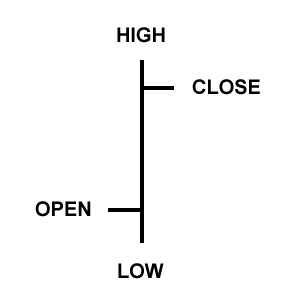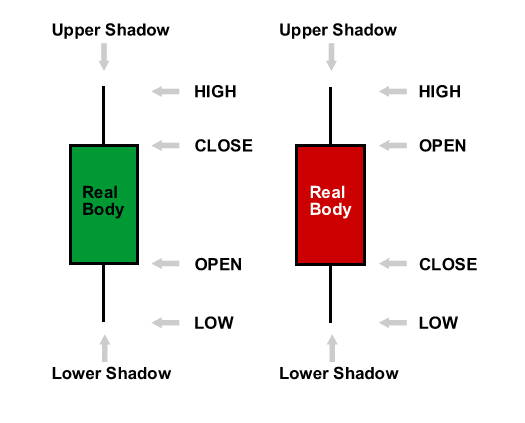As a Stock or Options Trader the quest to find the right entry point is best done with the use Technical Analysis of Stocks Trends. Whether you are a Trend Trader or Non Directional Trader, the use of Technical Analysis can form the foundation of your Trading research and your Written Trading Plan.
But before I start, there are many ways to uses Technical Analysis, you’ve just got to find a method and a time-frame that suits you. Here is my first post of my basic guide to Technical Analysis of Stock Trends to get you started
Chart Types
There are a few different chart types you can use to do your Technical Analysis, the 2 most commonly used charts are OHLC Bar Charts and Candlestick Charts.
OHLC Bar Charts
Bar charts are very simple in design, with each bar vertically spanning between the high and the low prices of the time period, with a horizontal bar on the left at the opening price and a horizontal bar on the right at the closing price.

OHLC Bar Charts are a little more sophisticated than a simple line chart, as they offer more information, with the Open, High Low and Close of each bar. With this extra information it is much easier to see whether the buyers or the sellers are in control in each bar. Also when the information of each bar is compared to other recent bars, it can also shed more light on whether the Bulls or the Bears are in control in the overall trend.
Candlesticks Charts
 Candle stick charts were first invented and used by 17th century Japanese Rice Traders, with great success. They are different by design to bar charts, although displaying the same information in a more graphical form.
Candle stick charts were first invented and used by 17th century Japanese Rice Traders, with great success. They are different by design to bar charts, although displaying the same information in a more graphical form.
As indicated by the image to the left, each candle has a “Real Body” which shows the relationship between Open and the Close of each period. If the Close is Higher than the Open, the candle body is usually white or green, or if the Close is lower than the Open the candle is typically Black or Red. Then the wick or Upper Shadow at the top of the real body represents the High of the period and the Lower Shadow at the bottom of the real body represents the Low.
I personally prefer Candlestick charts to conduct my Technical Analysis of Stock Trends because they make the charts much easier to read. The price action within each candlestick is also much easier to read, and when certain combinations of different candlestick form, they can help identify turning points, continuations, and support and resistance. I will cover some basic Candlestick Analysis in a future post.

Choosing a Chart Type
Choosing a Stock Market Chart Type is a personal preference. Though Candlestick Charts in my opinion trump Bar Charts, with their readablity and the fact you can also do Japanese candlestick analysis in combination with what ever Technical Analysis you choose. If Candlestick Charts are your preference, I recommend learning how to apply Japanese Candlestick Analysis, as it a techinque which will help you glean extra information out of each chart.
I hope you have found this information useful.
So stay tuned for next weeks post on “Technical Analysis of Stock Trends #2 – Chart Overlays”
Cade Arnel
Trend Hunter
www.globaltrendtraders.com 2009-2010
Here is an article for the more advanced traders out there:
(better put your thinking caps on)
- George Soros Theory of Reflexivity MIT Speech – The MIT Department of Economics World Economy Laboratory Conference Washington, DC Delivered April 26, 1994. When Rudi Dornbusch invited me to speak at this conference, he gave me a totally free hand in deciding what I wanted to talk …

2 Replies to “Technical Analysis of Stock Trends #1 – Chart Types”